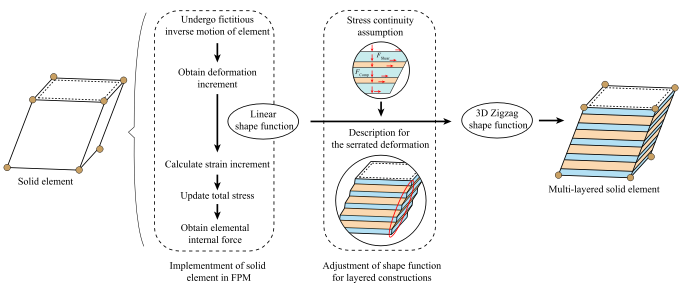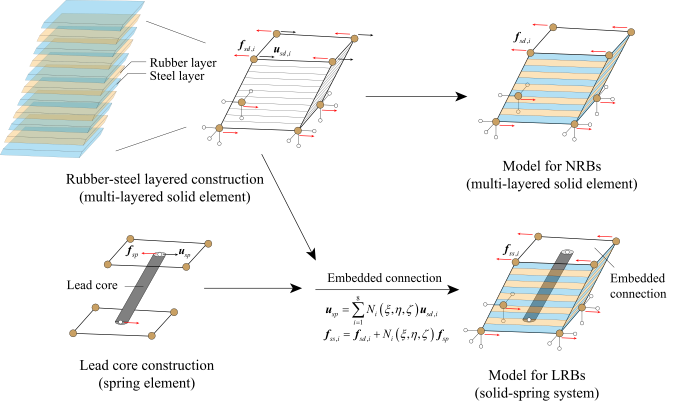Recently, the engineering simulation software team of the Future City (Smart City) Laboratory at Zhejiang University's Yangtze River Delta Smart Oasis Innovation Center published an innovative article titled Multi Layered Solid Element for Seismic Analysis of Rubber Bearings Considering Stress Continuity Based on Finite Particle Method in the top journal Engineering Structures in the Engineering Technology Zone 1. Yao Junjie, a doctoral student at the Future City (Smart City) Laboratory of the Smart Oasis Innovation Center, is the first author of the paper, and Zheng Yanfeng, a dual hired scholar, is the corresponding author of the paper.

The paper proposes a novel layered solid element based on the Finite Particle Method (FPM) for modeling layered structures, which is suitable for high-performance simulation of laminated rubber bearings in isolation systems and can be effectively used for seismic analysis of engineering isolation structures.
Base isolation is a highly effective seismic strategy for structures. Its core principle is to install flexible devices at the bottom of the structure to concentrate the horizontal displacement of the structure under earthquake action on the isolation layer at the bottom, thereby reducing the acceleration and internal force response of the upper structure. For common seismic isolation bearings such as rubber bearings, traditional simplified modeling methods ignore the layered structure of rubber bearings, which has limitations in universality and scalability. Fine modeling, due to the generation of a large number of nodes and elements, leads to high computational costs.

This study proposes a layered solid element based on the finite particle method, which balances the accuracy and efficiency of support modeling. It can conveniently apply various universal three-dimensional material constitutive models (such as rubber hyperelastic constitutive model and steel bilinear constitutive model) to the material layers inside the element. The study extends the traditional layered Zigzag shape function to three-dimensional space, ensuring the continuity of interlayer forces in materials, and efficiently simulating the deformation process of layered structures with a single unit. Compared with refined multi-body models, the computational acceleration ratio is 19 times. Based on layered solid units, corresponding calculation models were proposed for two types of bearings, natural rubber bearings (NRBs) and lead rubber bearings (LRBs), and the layered solid models were verified through bearing experiments to accurately capture the hysteresis behavior of the two types of rubber bearings.

This layered solid unit provides an innovative solution for efficient simulation of complex rubber bearings in seismic isolation systems. With the continuous advancement of computing hardware and parallel technology, the application of layered solid elements in large-scale structural seismic time history analysis will become more extensive and in-depth. In addition, by combining intelligent algorithms and data-driven methods, layered solid units are expected to achieve parameter optimization design and rapid simulation of rubber bearings, in order to improve the design efficiency of engineering structures. This method also has the potential for expansion and can be applied to other engineering structures with layered characteristics, opening up more possibilities for structural engineering simulation and design.
This study was supported by the National Key Research and Development Program (2023YFC3805600) and the National Natural Science Foundation of China (522380015237820352308218 and 52008366).
Paper link:
https://doi.org/10.1016/j.engstruct.2024.118713
Author Profile:
Yao Junjie, a doctoral student at the School of Architecture and Engineering, Zhejiang University, is a core member of the engineering simulation software team at the Future City (Smart City) Laboratory of the Zhejiang University Yangtze River Delta Smart Oasis Innovation Center. He mainly engages in research on structural seismic reduction and isolation simulation, and has participated in the National Natural Science Foundation Key Project (52238001) and multiple National Natural Science Foundation Youth Science Fund projects. He has published three academic papers in Engineering Structures, Journal of Building Structures, and Engineering Mechanics.
Zheng Yanfeng is a specially appointed researcher and doctoral supervisor at the School of Architecture and Engineering, Zhejiang University. He is also a double hired scholar at the Future City (Smart City) Laboratory of Zhejiang University's Yangtze River Delta Smart Oasis Innovation Center. He graduated with both a bachelor's and doctoral degree from Zhejiang University and is a visiting scholar at Kyoto University in Japan. My research interests include complex structural behavior, strong dynamic load effects on structures, deep spatial structures, artificial intelligence, and computational mechanics. Hosted 3 projects funded by the National Natural Science Foundation of China (including key sub projects), 1 project funded by the Zhejiang Provincial Natural Science Foundation, participated in 4 national level scientific research projects, contributed to the compilation of 1 national industry standard, and worked in Engineering Structures Thin-Walled Structures、Journal of Constructional Steel Research、 More than 30 academic papers have been published in authoritative domestic and foreign journals such as Journal of Architectural Structures and Engineering Mechanics, and the results have been applied in projects such as the structure of the Jiangmen Neutrino Experiment detector, a national scientific facility. Serving as a member of the Journal of Building Engineering Structures、Advances in Structural Engineering、 Reviewer for journals such as Journal of Shanghai Jiao Tong University, Journal of Earthquake Engineering, and Vibration and Shock.
Journal Introduction:
Engineering Structures is an internationally recognized top academic journal in the field of civil engineering, founded by Elsevier BV Publishing Group in 1978. It is a top journal in JCR-1 and the first district of the Chinese Academy of Sciences, with a current impact factor of 5.6. This journal is renowned for its comprehensive research in the field of civil engineering, covering a wide range of research topics including but not limited to foundation engineering, earthquake engineering, structural dynamics, structure fluid soil interactions, wind engineering, structural health monitoring, structural optimization, and data-driven analysis methods.


